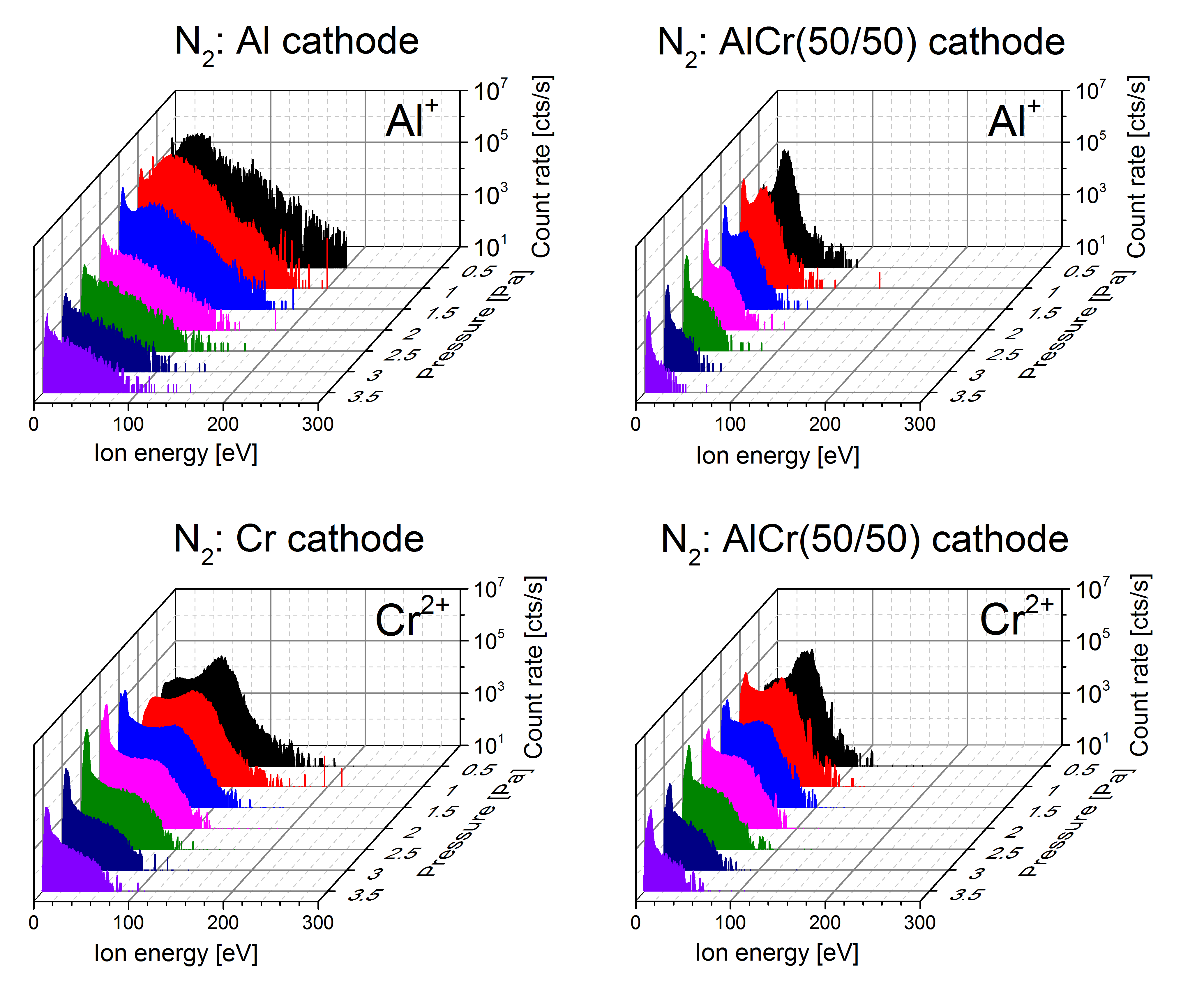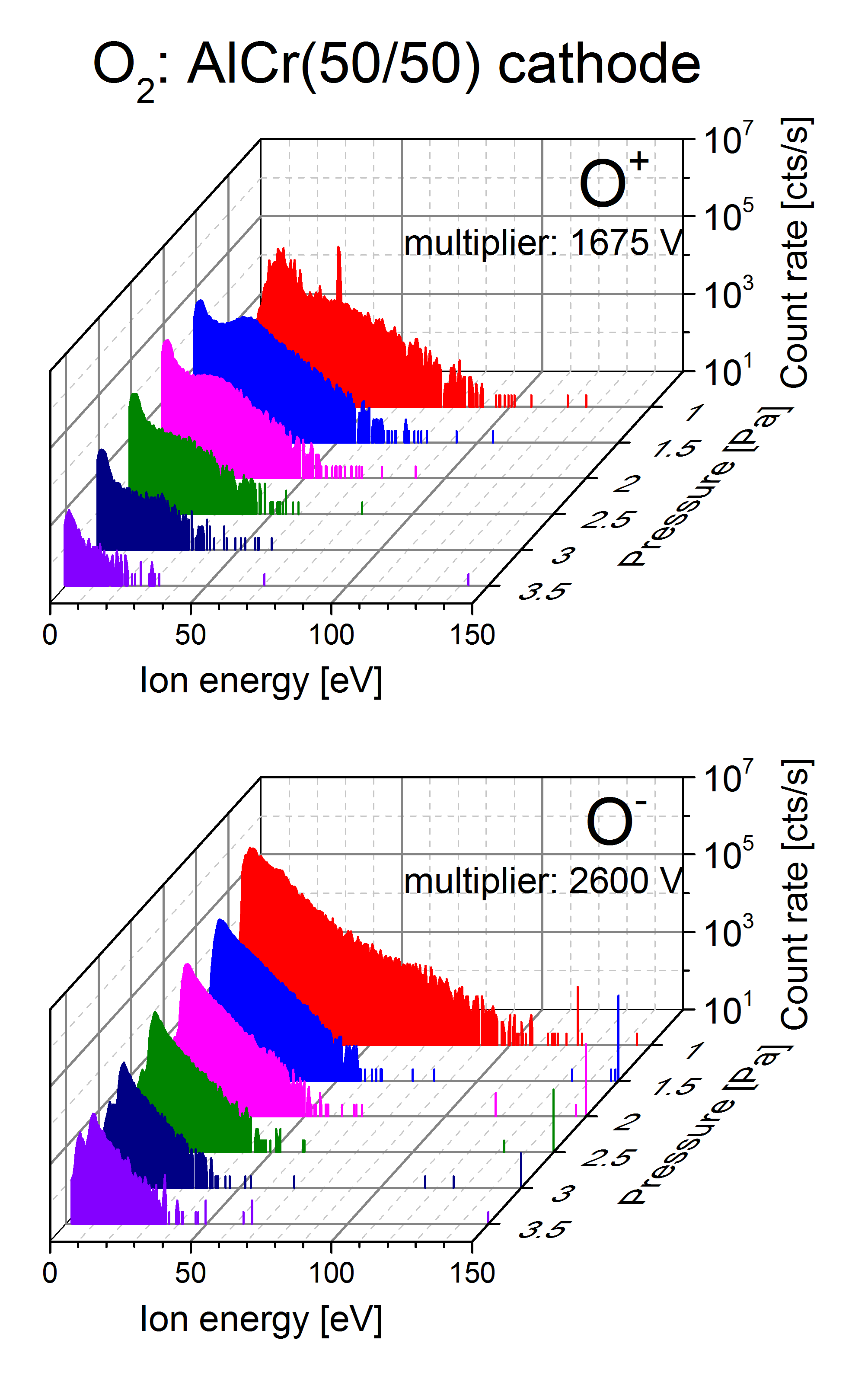Cathodic arc plasmas are frequently applied to deposit wear-resistant coatings like Al-Cr-N and Al-Cr-O. The metals are introduced as cathodes which are eroded due to the interaction with the plasma. Placing substrates in the plasma stream, metal ions and atoms can condensate on the substrates and a film or coating can grow. Reactive gases like N2 or O2 are added in order to enable the synthesis of nitrides, oxides or oxynitrides. Cathodic arc discharges are typically characterised by a high degree of ionisation which allows for controlling the film growth. By applying a negative bias voltage on the substrates the positively charged ions from the plasma are accelerated towards the substrate resulting in a densification of the growing film. However, even though the fundamentals of cathodic arc discharges have been studied in great detail in the past decades, the plasma properties actually present in the deposition processes to synthesise wear-resistant coatings have only been scarcely investigated.
We measured the ion energy distribution functions (IEDFs) in DC cathodic arc plasmas (current: 50 A) from single-element Al and Cr as well as three composite AlCr cathodes with compositions of 75/25, 50/50 and 25/75 at.%. The gas pressure in the inert Ar and the reactive N2 and O2 atmospheres was varied from 0.5 to 3.5 Pa. We used a combined ion energy-per-charge and mass-per-charge analyser (HIDEN EQP 300) to record the IEDFs element- and charge-state-resolved as a function of the gas pressure and cathode composition. The following positively and negatively charged ions were analysed: Al+, Al2+, Al3+, Cr+, Cr2+, Cr3+, Ar+, Ar2+, N+ , N2+, N2+ , O+, O2+, O2+, AlO+, CrO+, O–, O2– , AlO– and CrO–.

Figure 1: IEDFs of Al+ and Cr2+ ions from single-element Al and Cr as wells as from a composite AlCr cathode with a composition of 50/50 at.% at different N2 gas pressures.
Even though multiply charged ions with high energy are present in vacuum arc discharges, a significant reduction in the mean ion charge state, the ion energy and the number of ions is observed with increasing gas pressure regardless of the cathode composition. However, the choice of the cathode material also influences the plasma properties as generally lower ion energies and charge states were observed in the arc plasma from the composite than from the single-element cathodes (see examples in Figure 1).

Figure 2: IEDFs of O+ and O– ions from a composite AlCr cathode with a composition of 50/50 at.% at different O2 gas pressures.
In addition to the positively charged ions, also negatively charged ions were observed in the arc discharges in O2 atmosphere. The fraction of negatively charged oxygen ions was estimated to about 1% of the entire oxygen-containing ions observed and the effect on film growth is therefore expected to be insignificant. Their IEDFs are similar to the IEDFs of positively charged ions (see Figure 2) indicating that the ion acceleration in arc discharges is primarily due to gas expansion. High energy negative ions, which are typically recorded in magnetron discharges with oxygen, are absent in arcs since no high voltage is present in the cathode sheet or any other part of the arc discharge.
Paper Reference: “Element- and charge-state-resolved ion energies in the cathodic arc plasma from composite AlCr cathodes in argon, nitrogen and oxygen atmospheres”, Surface and Coatings Technology 2015, 272, 309–321. doi:10.1016/j.surfcoat.2015.03.047.
Download Project Summary: AP0971
Project summary by:
 Robert Franz, Montanuniversität Leoben, Franz-Josef-Strasse 18, 8700 Leoben, Austria
Robert Franz, Montanuniversität Leoben, Franz-Josef-Strasse 18, 8700 Leoben, Austria
 André Anders, Lawrence Berkeley National Laboratory, 1 Cyclotron Road, Berkeley, California 94720, USA
André Anders, Lawrence Berkeley National Laboratory, 1 Cyclotron Road, Berkeley, California 94720, USA
To find out more about this product visit the EQP product page or if you would like to contact us directly please Send us a Message.

